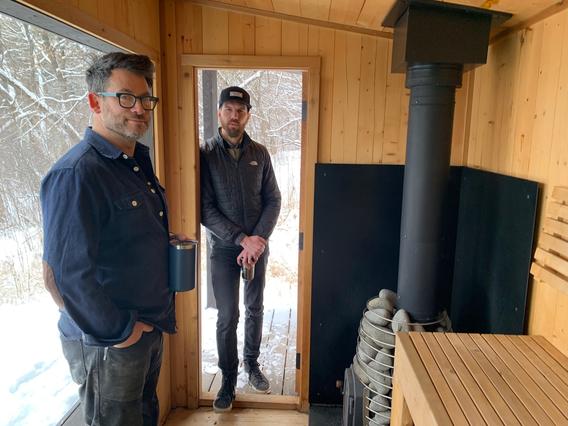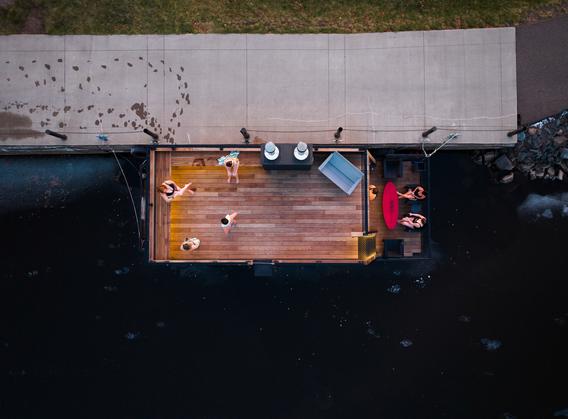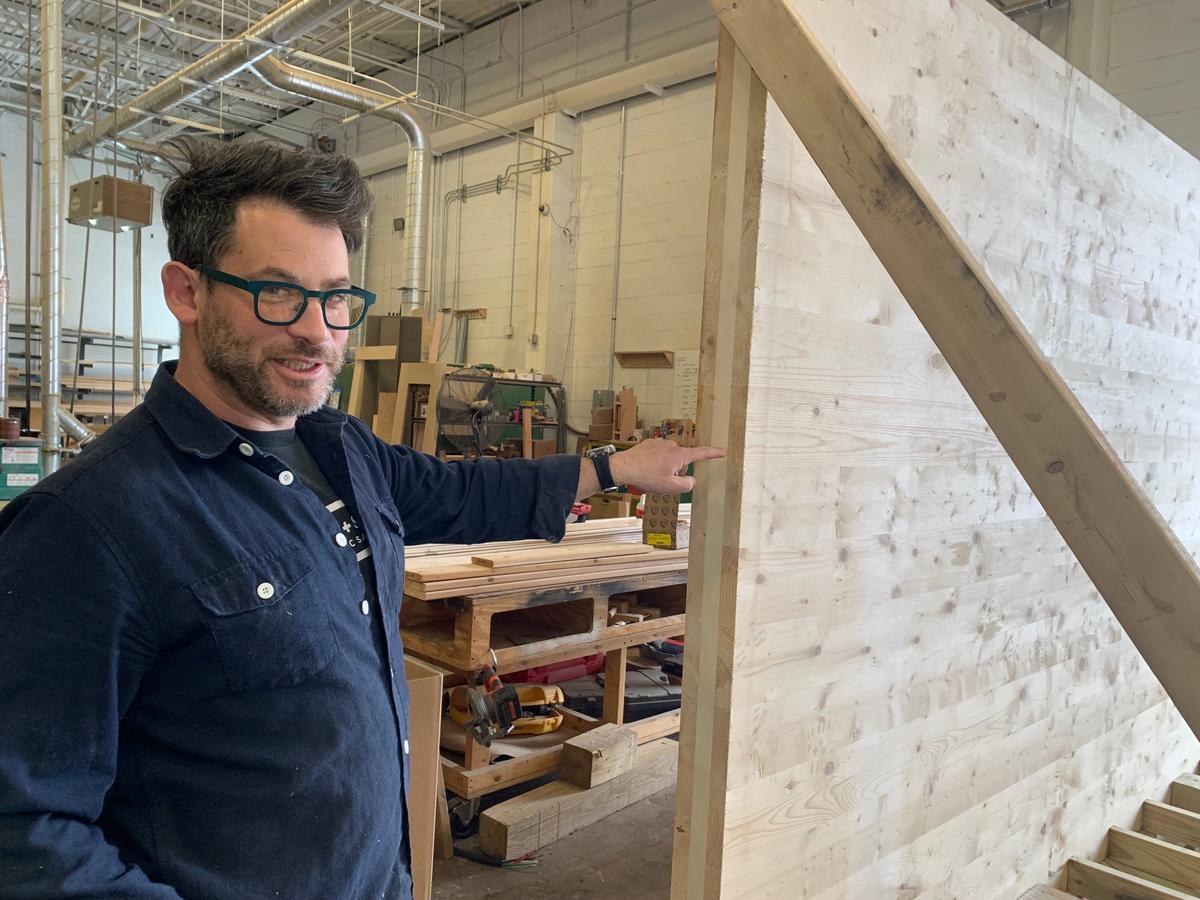No one knows for sure how old the sauna tradition is. Some literature dates the heat and steam bathing ritual to before 7,000 BCE in Finland.
But with the help of NRRI, two entrepreneurs are bringing new materials science to this well-loved tradition by subjecting cross-laminated and thermally modified wood to the extremes of the sauna environment.
“Moisture and extreme temperature swings are the enemy of wood,” said Joel Vikre, co-founder of Cedar and Stone Saunas. “Saunas go up to 200 to 210 Fahrenheit, then you walk away, and in the winter it’ll drop to well below zero pretty quickly.”
Traditional saunas in Europe are made with logs, “the gold standard,” according to Vikre. Solid wood construction doesn’t have gaps to hold moisture and heat gets evenly distributed inside.
But Vikre, and fellow co-founder Justin Juntunen, are innovating with cross laminated timber, sometimes called mass timber, for walls and floors. And they’re using thermally modified wood for siding and architectural design points.
The men were introduced to the materials science behind these wood innovations by NRRI’s wood products industry specialist, Patrick Donahue, who recently retired.
“As entrepreneurs, we have a weird penchant for risk,” said Juntunen. “We go out and try new things, but we need that backup of science and data to support what we want to try. NRRI is a catalyst for us. We need their rigorous research to support the things we want to do or problems we’re solving.”
Beautiful & Functional
Thermal modification is wood heated in a low oxygen kiln, essentially cooking the wood, to make it more dimensionally stable, water resistant and imparting a darker, “tropical” wood color throughout. This chemical-free process was industrially developed in Finland and is widely marketed in Europe, but the industry is nascent in the U.S. Over some 20 years, NRRI has been testing the process on many varieties of domestic wood species and engineered wood materials, developing specifications to expand its use.

As a result of NRRI’s research, Arbor Wood Co. started marketing thermally modified wood to high end architectural firms and is building a manufacturing plant in Bagley, Minn., that recently started up. Cedar and Stone plans to be one of their best customers.
“Working with Arbor Wood has been great. We’re like kindred spirits, growing alongside each other,” said Juntunen. (See video of their partnership here.)
The other wood innovation for their saunas – cross laminated timber – was more challenging to incorporate. A manufacturer in Ontario, Canada, had the materials but their processing backlog meant waiting a year for what they needed. So, with coaching from NRRI, Juntunen and Vikre decided to make their own.
Cross laminated timber, called CLT in the industry, is made of several layers of kiln-dried lumber boards stacked in alternating directions, bonded with structural adhesives, and pressed to form a solid, rectangular panel. Juntunen and Vikre found that it could be a modern version of solid logs for their saunas. They made their panels with specifically different wood species to impart unique properties. And they built a sauna that is still in active use by a client in Minneapolis.
“They love it. It’s a cool, cute building,” said Juntunen. “And still, no one has reproduced what we did with that CLT. But making those panels was a labor of love. It was very challenging.”
The Ontario manufacturer agreed to sell them raw, uncut CLT, which could be shipped in a reasonable timeframe. Again, with coaching from NRRI, they bought an extra large circular saw and learned to process the CLT for walls, windows and doors.
Eventually, Juntunen wants to expand their CLT processing with a computer numerical control (CNC) router and make up the cost by selling services to external clients.
“And that will get us closer to building our saunas with local wood, because what we get from Ontario is mostly spruce,” said Vikre. “We’d like to produce CLT with aspen, hemlock or white pine, which could be really interesting.”
Afloat
Today the company employs about 40 people in full and part-time positions, building about three custom saunas a month. Since starting in 2020, they’ve seen about 65 percent growth each year, as they continue to innovate in their construction methods.

And just to push the limits a bit further, a Cedar and Stone sauna is now afloat on Lake Superior near Canal Park in Duluth.
“So, CLT is wood and shouldn’t get wet, right? But we put it on a boat. And the deck is made from thermally modified wood with wood framed doors and windows,” said Vikre. “We’ll find out pretty quickly if we destroy them or they can handle it.”
Meanwhile, Cedar and Stone enjoys hosting new and experienced folks in Duluth and Minneapolis at their rental, community saunas, with a goal to host one million over the next decade.
“We’re a stress-destroying company,” said Juntunen. “And we also want to build as sustainably as possible. Our customers want something beautiful and they want saunas produced in America. We’re trying to create a vertically integrated system with locally sourced materials.”
NRRI Ongoing Research
NRRI continues to innovate with these materials, including developing a mass timber product from thermally modified wood.
NRRI Wood Products Program Manager, Matt Aro, is experimenting with wood strand-based mass timber materials produced from thermally modified balsam fir, a low-value, underutilized wood material commonly found in northern Minnesota. This project is funded by the U.S. Forest Service in partnership with Washington State University, the U.S. Forest Service Forest Products Laboratory, and industry.

NRRI and UMD’s Bureau of Business and Economic Research are also conducting a market feasibility study for a Swiss company looking to develop a unique wood strand composite material called “Scrimber.” The panels are efficiently made with higher performance and lighter weight than traditional mass timber.
“They want to scale-up and make prototypes of Scrimber panels for larger-scale testing, demonstration, and validation,” said Aro. “Our study will help them to better understand if it’s feasible to have a Scrimber plant in Minnesota.”
To learn more about NRRI’s Future Forest Industries strategic initiative, visit the webpage here.
PHOTO TOP: Joel Vikre talks about the cross laminated timber panels used to construct Cedar and Stone Nordic Saunas.
